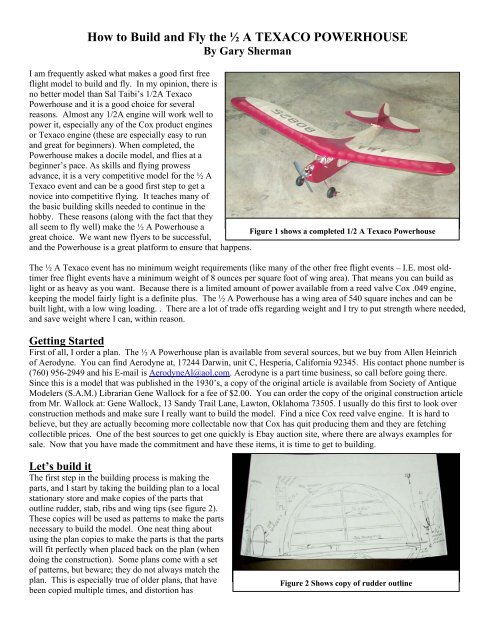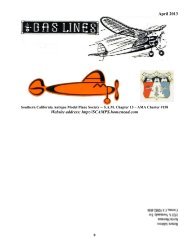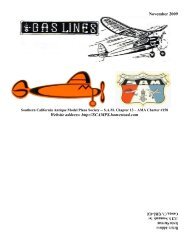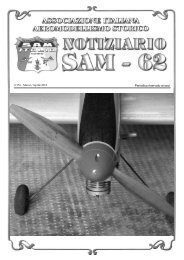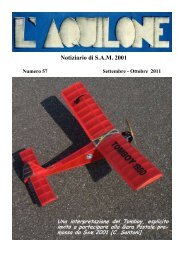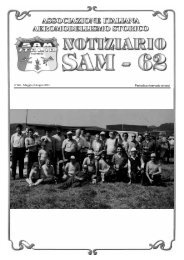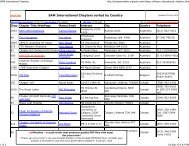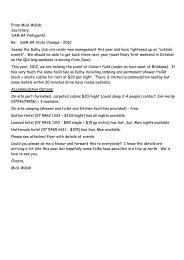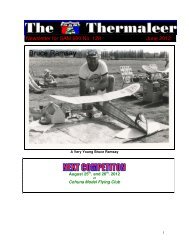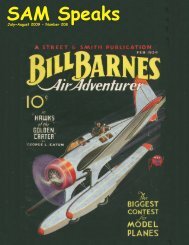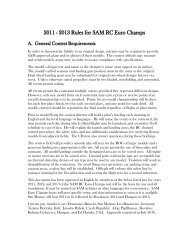Building the Powerhouse - Society of Antique Modelers
Building the Powerhouse - Society of Antique Modelers
Building the Powerhouse - Society of Antique Modelers
Create successful ePaper yourself
Turn your PDF publications into a flip-book with our unique Google optimized e-Paper software.
How to Build and Fly <strong>the</strong> ½ A TEXACO POWERHOUSE<br />
By Gary Sherman<br />
I am frequently asked what makes a good first free<br />
flight model to build and fly. In my opinion, <strong>the</strong>re is<br />
no better model than Sal Taibi’s 1/2A Texaco<br />
<strong>Powerhouse</strong> and it is a good choice for several<br />
reasons. Almost any 1/2A engine will work well to<br />
power it, especially any <strong>of</strong> <strong>the</strong> Cox product engines<br />
or Texaco engine (<strong>the</strong>se are especially easy to run<br />
and great for beginners). When completed, <strong>the</strong><br />
<strong>Powerhouse</strong> makes a docile model, and flies at a<br />
beginner’s pace. As skills and flying prowess<br />
advance, it is a very competitive model for <strong>the</strong> ½ A<br />
Texaco event and can be a good first step to get a<br />
novice into competitive flying. It teaches many <strong>of</strong><br />
<strong>the</strong> basic building skills needed to continue in <strong>the</strong><br />
hobby. These reasons (along with <strong>the</strong> fact that <strong>the</strong>y<br />
all seem to fly well) make <strong>the</strong> ½ A <strong>Powerhouse</strong> a<br />
Figure 1 shows a completed 1/2 A Texaco <strong>Powerhouse</strong><br />
great choice. We want new flyers to be successful,<br />
and <strong>the</strong> <strong>Powerhouse</strong> is a great platform to ensure that happens.<br />
The ½ A Texaco event has no minimum weight requirements (like many <strong>of</strong> <strong>the</strong> o<strong>the</strong>r free flight events – I.E. most oldtimer<br />
free flight events have a minimum weight <strong>of</strong> 8 ounces per square foot <strong>of</strong> wing area). That means you can build as<br />
light or as heavy as you want. Because <strong>the</strong>re is a limited amount <strong>of</strong> power available from a reed valve Cox .049 engine,<br />
keeping <strong>the</strong> model fairly light is a definite plus. The ½ A <strong>Powerhouse</strong> has a wing area <strong>of</strong> 540 square inches and can be<br />
built light, with a low wing loading. . There are a lot <strong>of</strong> trade <strong>of</strong>fs regarding weight and I try to put strength where needed,<br />
and save weight where I can, within reason.<br />
Getting Started<br />
First <strong>of</strong> all, I order a plan. The ½ A <strong>Powerhouse</strong> plan is available from several sources, but we buy from Allen Heinrich<br />
<strong>of</strong> Aerodyne. You can find Aerodyne at, 17244 Darwin, unit C, Hesperia, California 92345. His contact phone number is<br />
(760) 956-2949 and his E-mail is AerodyneAl@aol.com. Aerodyne is a part time business, so call before going <strong>the</strong>re.<br />
Since this is a model that was published in <strong>the</strong> 1930’s, a copy <strong>of</strong> <strong>the</strong> original article is available from <strong>Society</strong> <strong>of</strong> <strong>Antique</strong><br />
<strong>Modelers</strong> (S.A.M.) Librarian Gene Wallock for a fee <strong>of</strong> $2.00. You can order <strong>the</strong> copy <strong>of</strong> <strong>the</strong> original construction article<br />
from Mr. Wallock at: Gene Wallock, 13 Sandy Trail Lane, Lawton, Oklahoma 73505. I usually do this first to look over<br />
construction methods and make sure I really want to build <strong>the</strong> model. Find a nice Cox reed valve engine. It is hard to<br />
believe, but <strong>the</strong>y are actually becoming more collectable now that Cox has quit producing <strong>the</strong>m and <strong>the</strong>y are fetching<br />
collectible prices. One <strong>of</strong> <strong>the</strong> best sources to get one quickly is Ebay auction site, where <strong>the</strong>re are always examples for<br />
sale. Now that you have made <strong>the</strong> commitment and have <strong>the</strong>se items, it is time to get to building.<br />
Let’s build it<br />
The first step in <strong>the</strong> building process is making <strong>the</strong><br />
parts, and I start by taking <strong>the</strong> building plan to a local<br />
stationary store and make copies <strong>of</strong> <strong>the</strong> parts that<br />
outline rudder, stab, ribs and wing tips (see figure 2).<br />
These copies will be used as patterns to make <strong>the</strong> parts<br />
necessary to build <strong>the</strong> model. One neat thing about<br />
using <strong>the</strong> plan copies to make <strong>the</strong> parts is that <strong>the</strong> parts<br />
will fit perfectly when placed back on <strong>the</strong> plan (when<br />
doing <strong>the</strong> construction). Some plans come with a set<br />
<strong>of</strong> patterns, but beware; <strong>the</strong>y do not always match <strong>the</strong><br />
plan. This is especially true <strong>of</strong> older plans, that have<br />
been copied multiple times, and distortion has<br />
Figure 2 Shows copy <strong>of</strong> rudder outline
occurred. It is always a good idea to look over a plan and make sure everything looks correct. Make sure <strong>the</strong> wing will fit<br />
<strong>the</strong> wing saddle; <strong>the</strong> stab fits properly on <strong>the</strong> fuselage, etc.<br />
Do a take-<strong>of</strong>f <strong>of</strong> <strong>the</strong> wood supplies that will be needed. The necessary balsa can be purchased from several balsa<br />
suppliers. I always order more than I need so I can pick <strong>the</strong> weight <strong>of</strong> <strong>the</strong> wood I want for a particular part. There is a<br />
selection <strong>of</strong> light wood known as “Contest Wood” and this should be used in several areas to save weight and help later<br />
with <strong>the</strong> Center <strong>of</strong> Gravity. This will be explained more later, but most models tend to come out tail heavy, so building a<br />
light rudder and stab will help this.<br />
Now that you have your copies made and your supply <strong>of</strong> balsa<br />
wood, you can start making <strong>the</strong> parts. Start by cutting out <strong>the</strong><br />
parts <strong>of</strong> <strong>the</strong> copies.<br />
Then, using a<br />
temporary type<br />
glue stick put some<br />
glue on <strong>the</strong> back<br />
side <strong>of</strong> <strong>the</strong> paper<br />
and paste <strong>the</strong>m<br />
onto <strong>the</strong> proper<br />
thickness and<br />
weight <strong>of</strong> wood<br />
Figure 3 Gluing back <strong>of</strong> pattern<br />
Figure 4 Line up grain and paste pattern to wood<br />
(see figure 3).<br />
Temporary glue sticks are available at most stationery stores. Most <strong>of</strong> <strong>the</strong><br />
plans show <strong>the</strong> direction <strong>the</strong> grain on <strong>the</strong> wood should go, and it is important to pay attention to this as you paste your<br />
patterns on (see figure 4). I make all <strong>the</strong> perimeter parts out <strong>of</strong> contest wood. Contest wood is classified as 6 pound or<br />
less per cubic foot. Using some basic math, and a good scale, you can calculate <strong>the</strong> “poundage” <strong>of</strong> all <strong>the</strong> wood you will<br />
use. The reason I use light wood on <strong>the</strong>se parts is because <strong>the</strong>y are thick enough, that <strong>the</strong>y do not need <strong>the</strong> strength <strong>the</strong><br />
heavier wood might add. Again, saving weight where you can is always advisable.<br />
Once you have your paper pattern pasted<br />
to <strong>the</strong> wood, you may want to stack<br />
more than one part under <strong>the</strong> pattern.<br />
Things like wing tips require two <strong>of</strong><br />
each part, so by stacking <strong>the</strong>m, you can<br />
make two at a time. You can ei<strong>the</strong>r put<br />
a tiny bit <strong>of</strong> CA glue between <strong>the</strong> parts<br />
(very little so <strong>the</strong>y can be separate later),<br />
or use a straight pin through both (see<br />
figure 5). Rough cut <strong>the</strong> parts around<br />
<strong>the</strong> patterns and leave enough so <strong>the</strong>y<br />
Figure 5 cutting a second stacked part can be sanded to <strong>the</strong> final fit. I use our<br />
scroll saw to cut out <strong>the</strong> parts. It<br />
helps a lot to have a scroll saw, but<br />
<strong>the</strong> parts could also be cut out with Figure 6 sanding inside radius<br />
an X-acto knife or a sharp single<br />
edge razor blade. I think it is much<br />
safer, faster and precise to use a scroll saw. Mine is a Makita brand and I<br />
bought it at a local hardware store for under $100. Once <strong>the</strong> parts are<br />
rough cut out, <strong>the</strong>y can be sanded. You can hand sand <strong>the</strong>m, but I prefer to<br />
use a stationary belt sander which I also purchased from <strong>the</strong> local<br />
hardware. It has <strong>the</strong> advantages <strong>of</strong> keeping <strong>the</strong> parts square, and saving a<br />
lot <strong>of</strong> time. I also utilize <strong>the</strong> round top portion <strong>of</strong> <strong>the</strong> sander to do inside<br />
Figure 7 handy disc sander<br />
radiuses (see figure 6). One <strong>of</strong> <strong>the</strong> handiest tools I have for making parts is<br />
a small disc sander. It was custom made, and <strong>the</strong> exact type is no longer<br />
available. Similar precision disc sanders can be had. It is also very handy all through construction (see figure 7).
One <strong>of</strong> <strong>the</strong> best things to come along in a while to add a lot <strong>of</strong> strength,<br />
but not a lot <strong>of</strong> weight is carbon fiber, and I do utilize it in certain<br />
applications. I like to apply a little medium CA glue, and rub <strong>the</strong><br />
carbon down with a paper towel to set <strong>of</strong>f <strong>the</strong> glue and get a good<br />
bond. Refer to figure 8 which shows me making a laminated spar for<br />
<strong>the</strong> <strong>Powerhouse</strong> stab. The carbon is placed on one side <strong>of</strong> <strong>the</strong> spar, and<br />
<strong>the</strong>n <strong>the</strong> o<strong>the</strong>r side <strong>of</strong> <strong>the</strong> spar is placed over <strong>the</strong> top, sandwiching <strong>the</strong><br />
carbon. This is done by using ½ <strong>the</strong> thickness <strong>of</strong> <strong>the</strong> wood shown on<br />
<strong>the</strong> plan. In example, if <strong>the</strong> plan calls for a 1/8 spar (as is <strong>the</strong> case <strong>of</strong><br />
<strong>the</strong> ½ A <strong>Powerhouse</strong> stab which is 1/8” x 1/2”), using <strong>the</strong> carbon built<br />
up spar, use 1/16” balsa, carbon, and ano<strong>the</strong>r 1/16” balsa. The carbon<br />
I use is a unidirectional carbon, .007” thick. I purchase it from<br />
Figure 8 building a carbon laminated spar<br />
Aerospace Composite Products, web site:<br />
http://www.acp-composites.com/ACP-CAT.HTM but it can also be ordered from several o<strong>the</strong>r sources including many<br />
model hobby suppliers. By being unidirectional, it is very stiff in one direction, and is ideal for this type <strong>of</strong> application. I<br />
glue about 6 inches at a time and wipe it down with a paper towel until it kicks <strong>the</strong> glue, and <strong>the</strong>n lift <strong>the</strong> carbon and do<br />
ano<strong>the</strong>r 6 inches. This works great and is much easier than trying to glue <strong>the</strong> entire piece at once. Towards <strong>the</strong> end <strong>of</strong><br />
wiping <strong>the</strong> glue, a shot <strong>of</strong> CA kicker and more wiping will ensure <strong>the</strong> glue is fully cured. Because <strong>the</strong> <strong>Powerhouse</strong> stab<br />
only has one spar, this lamination will help keep it from wanting to warp upward when <strong>the</strong> covering is applied. The stab<br />
is supposed to be flat on <strong>the</strong> bottom, and sanded to an airfoil on top. The covering tends to pull <strong>the</strong> flat bottom up like a<br />
truss as <strong>the</strong> covering draws tight.<br />
Starting assembly<br />
I build right over <strong>the</strong> plan, but only after I apply Saran Wrap or<br />
Wax paper over <strong>the</strong> plan so <strong>the</strong> glue will not stick your parts to<br />
it. Ei<strong>the</strong>r works as a release for <strong>the</strong> parts. If you glue your parts<br />
to <strong>the</strong> plan, you will have a real mess, so be sure to use one <strong>of</strong><br />
<strong>the</strong> above suggested. I like Saran Wrap, while my son prefers<br />
Wax paper. As I said, ei<strong>the</strong>r works fine.<br />
I used thin CA glue for most <strong>of</strong> my building, and apply it<br />
through a Teflon glue tip with a 1/16” outside diameter (Figure<br />
9). These tips can be bought for about $.50 each and <strong>the</strong>re are a<br />
Figure 9 Gluing parts over protected plan<br />
couple styles. One fits right over <strong>the</strong> stock glue bottle tip, and<br />
<strong>the</strong>n some is sold in 1-3 foot sections, and is inserted into <strong>the</strong> end<br />
<strong>of</strong> <strong>the</strong> glue bottle tip. That is <strong>the</strong> type I use, cutting a 1” piece. It is helpful<br />
to cut <strong>the</strong> side that will be inserted into <strong>the</strong> bottle on an angle to get it into<br />
<strong>the</strong> tip easier. By using this tip, it really helps control <strong>the</strong> flow <strong>of</strong> glue.<br />
Usually, only one drop is needed. Without using <strong>the</strong> applicator tip, <strong>the</strong><br />
glue just wants to run out. Try <strong>the</strong>m; you will be glad you did. When <strong>the</strong><br />
part is all built with thin CA and has had time to cure, I pick <strong>the</strong> part up<br />
and re-glue <strong>the</strong> joints<br />
with just a little more thin<br />
or medium CA (Figure<br />
10).<br />
Figure 10 re-gluing joints on rudder <strong>Building</strong> <strong>the</strong> rudder for<br />
<strong>the</strong> <strong>Powerhouse</strong> is pretty<br />
straight forward. The<br />
only modification I make from <strong>the</strong> plan is to add gussets to both side <strong>of</strong><br />
<strong>the</strong> rudder post as is visible in Figure 10. This helps to keep <strong>the</strong> glue<br />
joint solid after covering. Without <strong>the</strong>m, I have seen <strong>the</strong> rudder post<br />
actually crush into <strong>the</strong> bottom <strong>of</strong> <strong>the</strong> rudder, and fail. When <strong>the</strong><br />
assembly is all glued toge<strong>the</strong>r, I remove it from <strong>the</strong> plan and I re-glue<br />
each joint with a small amount <strong>of</strong> medium CA for additional strength. I<br />
Figure 11 sanding rudder flat both sides
only use a small amount, again being conscious <strong>of</strong> <strong>the</strong> overall weight. When dry, I sand both sides to get it flat and <strong>the</strong>n<br />
sand a uniform symmetrical airfoil to <strong>the</strong> leading and trailing edge (see figure 11).<br />
The stabilizer construction is done in much <strong>the</strong> same fashion as <strong>the</strong> rudder.<br />
After I have it built, and have re-glued all <strong>the</strong> joints, I sand <strong>the</strong> bottom <strong>of</strong> it<br />
flat. On <strong>the</strong> stab, a lifting airfoil is sanded on <strong>the</strong> top <strong>of</strong> <strong>the</strong> stab (refer to<br />
plan). When done right, it will have a flat bottom lifting stab.<br />
The first step in building <strong>the</strong> wing is making <strong>the</strong> wing ribs. I use a copy<br />
made from <strong>the</strong> plan<br />
and affix it to a<br />
piece <strong>of</strong> 1/8”<br />
plywood. I <strong>the</strong>n<br />
temporarily glue<br />
ano<strong>the</strong>r 1/8” piece<br />
<strong>of</strong> plywood to <strong>the</strong><br />
Figure 13 drilling holes in roughed out balsa ribs<br />
rough cut (oversize) my balsa ribs and a few at a time, drill <strong>the</strong> 1/8”<br />
holes through <strong>the</strong>m, using one <strong>of</strong> my 1/8” rib templates as a guide<br />
(see figure 13). I can usually stack ½ <strong>of</strong> <strong>the</strong> needed ribs between <strong>the</strong><br />
templates at a time to finish <strong>the</strong>m, making all my ribs in two batches.<br />
With half <strong>the</strong> ribs sandwiched between my two finished templates,<br />
and 1/8” dowels<br />
running through all, I<br />
sand <strong>the</strong> balsa ribs to<br />
<strong>the</strong> shape <strong>of</strong> <strong>the</strong><br />
templates. When that is<br />
done, I am ready to cut<br />
in my spars notches. I<br />
Figure 15 making trailing edge<br />
Figure 12 <strong>the</strong> start <strong>of</strong> rib templates<br />
first and drill two 1/8” holes through both pieces <strong>of</strong> plywood<br />
(see figure 12). I insert 1/8” dowels in <strong>the</strong> holes to hold all my<br />
ribs between <strong>the</strong> two completed templates and <strong>the</strong> holes will act<br />
as a vent when <strong>the</strong> wing is constructed. I sand and finish <strong>the</strong> two<br />
plywood templates to <strong>the</strong> outline and separate <strong>the</strong>m. Now, <strong>the</strong>y<br />
are ready<br />
to be used<br />
to make<br />
ribs. I<br />
Figure 14 cutting notches for spars<br />
have a Dremel and a Micro-Mark table saw, and both work well for this<br />
operation. Before I had <strong>the</strong> saws, I would cut <strong>the</strong>m in using a Zona saw and<br />
assorted files to get <strong>the</strong>m to <strong>the</strong> correct size. With a table saw, I make several<br />
passes adjusting a little<br />
at a time to get <strong>the</strong><br />
correct notch width (see<br />
figure 14). I also use a<br />
cheap set <strong>of</strong> calipers to<br />
keep checking <strong>the</strong> notch<br />
size. When all <strong>the</strong><br />
notches are cut, I am<br />
ready to repeat <strong>the</strong>se<br />
steps to make <strong>the</strong> o<strong>the</strong>r<br />
batch <strong>of</strong> ribs.<br />
While you can buy <strong>of</strong>f <strong>the</strong> shelf trailing edge, I like to make my own<br />
Figure 16 shows 3/8" balsa tips installed<br />
(see figure 15). This allows me to make it at <strong>the</strong> correct angle to<br />
match my ribs and saves a lot <strong>of</strong> sanding later. I make my wing tip parts out <strong>of</strong> real light 3/8” balsa. This extra thickness
Figure 17 trailing edge is notched for ribs<br />
may add a little<br />
weight, but<br />
makes <strong>the</strong><br />
shape <strong>of</strong> <strong>the</strong> tip<br />
much better<br />
and makes it<br />
much easier to<br />
cover when<br />
completed (see<br />
figure 16). The<br />
tip is glued on<br />
flat, but <strong>the</strong><br />
front <strong>of</strong> <strong>the</strong><br />
trailing edge is<br />
Figure 18 <strong>the</strong> 3/8" tips allow complete shaping<br />
lifted to match <strong>the</strong> curvature <strong>of</strong> <strong>the</strong> rib which is not flat on <strong>the</strong> bottom. When <strong>the</strong> wing tips are glued to <strong>the</strong> wing, note that<br />
<strong>the</strong>y are not flat on <strong>the</strong> plan, but are actually up in <strong>the</strong> air as <strong>the</strong>y are lined up with <strong>the</strong> center <strong>of</strong> <strong>the</strong> leading edge and <strong>the</strong><br />
center <strong>of</strong> <strong>the</strong> trailing edge. This is correct. When<br />
sanding <strong>the</strong> tip to shape (see figure 18) a useful tip is<br />
to put masking tape on <strong>the</strong> ribs so you don’t<br />
accidentally start sanding <strong>the</strong>m away. You use <strong>the</strong><br />
ribs as a guide, but do not want to remove any<br />
material from <strong>the</strong>m. Also note in figure 18 how <strong>the</strong><br />
spars are cut and glued from <strong>the</strong> last rib to <strong>the</strong> tip.<br />
The wing’s center ribs are cut down 1/16” on top and<br />
bottom. This area is to be sheeted with 1/16” medium<br />
weight balsa. In <strong>the</strong> last few years, I have been<br />
utilizing .007 unidirectional carbon fiber at my<br />
dihedral joints as doublers (see figure 19). I have had<br />
real good luck with this method and it is very light.<br />
Using plywood or hard balsa doublers will work okay<br />
Figure 19 shows carbon fiber doublers for <strong>the</strong> spar joints<br />
too, but is a little heavier. The spars in <strong>the</strong> wing are<br />
picked and matched for weight. I try to use a medium<br />
weight <strong>of</strong> 8-12 pounds for <strong>the</strong> wing spars. It is important to match <strong>the</strong> weight and strength <strong>of</strong> <strong>the</strong> spars for <strong>the</strong> balance <strong>of</strong><br />
<strong>the</strong> wing and for <strong>the</strong> longevity <strong>of</strong> it. While <strong>the</strong> wing does not have to be as strong as those on bigger and faster models, it<br />
does have to be strong enough to<br />
withstand <strong>the</strong> impact <strong>of</strong><br />
de<strong>the</strong>rmalizing.<br />
Figure 20 wing on my hinging dihedral jig<br />
The <strong>Powerhouse</strong> has a flat center<br />
section, and both wing panels are<br />
attached at <strong>the</strong> appropriate angel<br />
and glued to <strong>the</strong> carbon doublers as<br />
well as in <strong>the</strong> butt-joint as shown in<br />
figure 19 and 20. I have made a<br />
special hinging board to set <strong>the</strong><br />
dihedral joints. Not only does this<br />
allow me to set <strong>the</strong> angle correctly,<br />
it also ensures that <strong>the</strong> wing remains<br />
straight and that <strong>the</strong> wing panels are<br />
not sweeping forward or back. The<br />
jig is made with a piano hinge and<br />
5/8” birch plywood (figure 20). I<br />
just use whatever is handy to space<br />
it up to <strong>the</strong> correct angle.
The Fuselage on <strong>the</strong> <strong>Powerhouse</strong> is a<br />
basic box frame construction. To get<br />
started, I weigh and find four<br />
medium/hard balsa longerons, 12-14 lb.<br />
wood. By matching <strong>the</strong> strength and<br />
weight <strong>of</strong> <strong>the</strong> longerons, <strong>the</strong> fuselage will<br />
build more uniform and will be strong.<br />
Balsa, weight and strength do tend to go<br />
hand-in-hand. If you did not take <strong>the</strong> time<br />
to match your longerons, <strong>the</strong> weakest will<br />
bend <strong>the</strong> easiest, and <strong>the</strong> strongest will try<br />
to go back to <strong>the</strong> natural straight shape.<br />
This will cause <strong>the</strong> fuselage to be shaped<br />
like a banana, which is not what we are<br />
looking for.<br />
Pin down <strong>the</strong> longerons and start making<br />
your cross pieces. For this, I use my disc<br />
sander get <strong>the</strong> final size, and make two<br />
parts at a time so when I am ready to build<br />
Figure 22 One side glued up<br />
Figure 21 shows one fuselage side on plan, note calipers, scale & angle finder<br />
Figure 23 sanding both sides flat<br />
<strong>the</strong> second half, I already have all <strong>the</strong> pieces made<br />
and <strong>the</strong>y are exactly <strong>the</strong> same as <strong>the</strong> first side.<br />
Figure 21 shows my first side made and <strong>the</strong> extra<br />
corresponding part for <strong>the</strong> second side above <strong>the</strong><br />
first side. I start making my cross pieces<br />
(diagonals) in <strong>the</strong> front where <strong>the</strong>y are <strong>the</strong> longest.<br />
If I make a mistake and one gets too short, I simply<br />
use it for <strong>the</strong> next smallest part. The parts get<br />
smaller as you work towards <strong>the</strong> back. When all <strong>the</strong><br />
diagonals are glued and <strong>the</strong> sheeting for <strong>the</strong> engine<br />
cheek is glued in place, I again lift <strong>the</strong> side <strong>of</strong>f <strong>the</strong><br />
plan and go over <strong>the</strong> joints with a little medium CA<br />
glue (see figure 22). Build <strong>the</strong> o<strong>the</strong>r side following<br />
<strong>the</strong> same steps and <strong>the</strong>n sand both <strong>of</strong> <strong>the</strong> sides flat<br />
Figure 24 sanding <strong>the</strong> corner <strong>of</strong> <strong>the</strong> windows round<br />
(see figure 23). I use a drum sander to sand <strong>the</strong><br />
curves in <strong>the</strong> corner <strong>of</strong> <strong>the</strong> window frame (see figure<br />
24). This makes for a nice looking curve, very<br />
uniform. I sometimes will also make sanders, by wrapping sand paper around tubes for sanding similar inside radius.
The front <strong>of</strong> <strong>the</strong> cabin, where <strong>the</strong>re is an upright, is a weak<br />
spot because <strong>the</strong> upright is bisected by <strong>the</strong> bottom outline<br />
<strong>of</strong> <strong>the</strong> window. To add strength in this area, I glue a piece<br />
<strong>of</strong> .007 thick unidirectional carbon fiber full height. This<br />
helps support <strong>the</strong> joint, and I have never had one break<br />
since using this method. You can also add ano<strong>the</strong>r<br />
upright, full height, to <strong>the</strong> inside where <strong>the</strong> carbon is glued<br />
in figure 25. Remember you are making a left and right<br />
side, so be conscious to glue <strong>the</strong> support to <strong>the</strong> correct side<br />
on each fuselage side.<br />
I am now ready to join <strong>the</strong> two halves. I start at <strong>the</strong> front<br />
Figure 25 carbon fiber added for strength on upright<br />
where <strong>the</strong> fuselage cross pieces are all <strong>the</strong> same length and<br />
make eight parts exactly <strong>the</strong> same length. I tape one side<br />
to a square, so I am sure it is straight up and down. I<br />
weight <strong>the</strong> sides down to <strong>the</strong> plan using lead weights (see<br />
figure 26). This gets everything square, and<br />
perpendicular. I also do this right over a top view. The<br />
<strong>Powerhouse</strong> plan does actually have a top view, it just<br />
specifies a width. So, I draw a top view on <strong>the</strong> back side<br />
<strong>of</strong> <strong>the</strong> plan, starting with a center line.<br />
With <strong>the</strong> sides rigged as shown in figure 26, I start gluing<br />
Figure 26 joining <strong>the</strong> two fuselage sides<br />
in <strong>the</strong> cross pieces. I glue in <strong>the</strong> bottom and <strong>the</strong> top cross<br />
pieces that I made earlier to <strong>the</strong> same length. After <strong>the</strong>se<br />
are glued in place a dry, I pull <strong>the</strong> sides toge<strong>the</strong>r in <strong>the</strong> back and this creates a natural flowing curvature. I sand <strong>the</strong> inside<br />
<strong>of</strong> both sides a little at <strong>the</strong> back so <strong>the</strong>y can be<br />
lined up and glued toge<strong>the</strong>r. This is where <strong>the</strong><br />
center line is very handy, as <strong>the</strong> back <strong>of</strong> <strong>the</strong><br />
fuselage should line up exactly over <strong>the</strong> center<br />
line when glued toge<strong>the</strong>r. This will ensure a<br />
straight fuselage. Then, I make <strong>the</strong> reaming cross<br />
pieces to fit <strong>the</strong> curvature created by gluing <strong>the</strong><br />
two sides toge<strong>the</strong>r at <strong>the</strong> back. Be sure you do not<br />
sand <strong>the</strong>m too thin at <strong>the</strong> back, as this is where <strong>the</strong><br />
de<strong>the</strong>rmalizer and snuffer (tubing used to snuff<br />
out <strong>the</strong> de<strong>the</strong>rmalizer fuse) tube will be added<br />
later.<br />
The firewall is made from 1/8” aircraft grade<br />
birch plywood. I use a modified countersink drill<br />
for <strong>the</strong> four 4 x 40 blind nuts placed in <strong>the</strong> firewall<br />
to mount my tank (see figure 27). This allows me<br />
to slightly countersink <strong>the</strong> blind nuts in and get<br />
Figure 27 firewall, tank-mount, countersink, blind nuts<br />
good glue joint. I press <strong>the</strong> blind nuts in after<br />
using Super Seam (an adhesive used to attach<br />
covering to metal and wood on full size aircraft) as glue. When it is dry, I go over it again with ano<strong>the</strong>r coat <strong>of</strong> Super<br />
Seam. You want to be sure to get <strong>the</strong>se glued in well, as you never want <strong>the</strong>m to fall out. Super Seam can be purchased<br />
from Aircraft Spruce, 225 Airport Circle, Corona, California, 92882. Their phone number is 951-372-9555. They are a<br />
supplier for home-builts and general aviation. Note <strong>the</strong> ring I added in figure 27. This was done so <strong>the</strong> blind nuts did not<br />
protrude through <strong>the</strong> front <strong>of</strong> <strong>the</strong> firewall when glued in place. Also note, it is <strong>of</strong>fset to <strong>the</strong> side, so <strong>the</strong> prop will be more
centered when we add left thrust. Before gluing<br />
<strong>the</strong> firewall in place, it is always a good idea to<br />
chase <strong>the</strong> threads with a 4 x 40 tap to make sure<br />
no glue got into <strong>the</strong> threads. Sal Taibi used to<br />
make <strong>the</strong> tank mounts like <strong>the</strong> one shown in figure<br />
27, but no longer does. The current SAM rules<br />
allow for 15cc <strong>of</strong> fuel, but <strong>the</strong> rule cycle is due to<br />
be voted on again, and <strong>the</strong>re is a movement to go<br />
to 8cc (<strong>the</strong> size <strong>of</strong> a stock Cox Texaco tank). It is<br />
beneficial to run a tank-mount as shown. It spaces<br />
<strong>the</strong> engine out to <strong>the</strong> proper location (without it, a<br />
spacer will have to be made to get <strong>the</strong> engine<br />
where it needs to be). Getting <strong>the</strong> engine in <strong>the</strong><br />
proper location will really help with balancing<br />
your model as <strong>the</strong>y almost always come out tail<br />
heavy. Cox engines have an o-ring in <strong>the</strong>m that is<br />
in <strong>the</strong> middle <strong>of</strong> <strong>the</strong> tank. When <strong>the</strong> tank is full,<br />
<strong>the</strong> o-ring is submerged in fuel. When it gets<br />
down to a half tank, it starts to be surrounded by<br />
air. Many times, this will leak and cause your<br />
engine to lean and only run ½ <strong>the</strong> tank and <strong>the</strong><br />
engine will stop.<br />
I bend <strong>the</strong> landing gear and glue it up between<br />
balsa sheet wood. When completed, <strong>the</strong><br />
sandwiched gear should line up with <strong>the</strong> fuselage<br />
uprights, where it can be secured well (see figure<br />
28).<br />
The hood (part that fits behind <strong>the</strong> engine is<br />
formed by wetting a piece <strong>of</strong> 1/16” balsa and<br />
taping it around a cylinder. I used a can <strong>of</strong> spray<br />
paint to wrap mine around, and secured it using<br />
masking tape until dry (see figure 29). By<br />
Figure 29 <strong>the</strong> formed hood for <strong>the</strong> <strong>Powerhouse</strong><br />
performing this part, it will take <strong>the</strong> bind out <strong>of</strong> it<br />
for fitting and is much less likely to crack later. I<br />
soak <strong>the</strong> wood in water, but some prefer to add a little ammonia to <strong>the</strong><br />
water thinking it helps with <strong>the</strong> bending process. I have had good luck<br />
with just using water, and don’t have to smell <strong>the</strong> ammonia. Ei<strong>the</strong>r will<br />
work. When it is dry, I fit it and glue it to <strong>the</strong> fuselage. The nose block<br />
under <strong>the</strong> engine can be fit and glued on now using medium balsa. Make<br />
sure you can reach all <strong>the</strong> screws that hold <strong>the</strong> tank to <strong>the</strong> firewall. About<br />
<strong>the</strong> last thing to add is <strong>the</strong> sun visor. After shaping and sanding <strong>the</strong> nose<br />
cowl blow out <strong>the</strong> dust and fuel pro<strong>of</strong> <strong>the</strong> inside area. I use slow drying<br />
epoxy thinned a little with lacquer thinner. A little thinner goes a long way.<br />
I mix and brush it on with an acid brush, being careful not to get any in <strong>the</strong><br />
blind nuts. It may take a few days to dry. A warm climate or room helps. I<br />
<strong>the</strong>n sand this area <strong>the</strong> best I can and brush on ano<strong>the</strong>r coat. This makes a<br />
shiny and smooth fuel-pro<strong>of</strong> engine area.<br />
COVERING WITH POLY SPAN<br />
I cover all my gas models with Polyspan as it is light and provides a<br />
strong, long-lasting finish. I also like how stable it is. Since it is a<br />
polyester base material, it is not affected by moisture like many <strong>of</strong> <strong>the</strong><br />
o<strong>the</strong>r coverings, like silk, or tissue. Polyspan is excellent and helps you<br />
have that consistent model you are looking for, with no surprise warps<br />
Figure 28 shows landing gear in place<br />
Figure 30 brushing on sanding sealer
showing up. Polyspan has a smooth side and a<br />
rougher side, where <strong>the</strong> fibers stick up. It is very hard<br />
to see <strong>the</strong> difference, but <strong>the</strong> smooth side is a little<br />
shinier, and with careful inspection, you can see <strong>the</strong><br />
fibers on <strong>the</strong> rough side. The smooth, shiny side goes<br />
out and is <strong>the</strong> finish side. As <strong>of</strong> now, <strong>the</strong> only color<br />
that Polyspan comes in is white (natural).<br />
To prepare <strong>the</strong> surfaces to be covered, I make sure all<br />
are sanded smooth and are blown clean. I brush on a<br />
coat <strong>of</strong> lacquer sanding sealer (see figure 30)<br />
everywhere <strong>the</strong> covering will contact <strong>the</strong> structure.<br />
That means <strong>the</strong> top and bottom <strong>of</strong> ribs, all <strong>the</strong><br />
perimeters, etc. I finish exclusively with nitrate dope,<br />
and have found <strong>the</strong> lacquer sanding sealer to be<br />
compatible. If you plan to use an alternative finish,<br />
make sure everything is compatible by making a test<br />
panel. After my sanding sealer is dry, I sand all <strong>the</strong><br />
surfaces with 220-320 grit paper and again blow <strong>the</strong><br />
surface clean with compressed air. I <strong>the</strong>n add a second<br />
coat <strong>of</strong> sanding sealer and sand it with 320 paper. You<br />
will notice <strong>the</strong> second coat will sand much easier and<br />
you will have a very smooth surface. Blow <strong>the</strong> dust<br />
<strong>of</strong>f <strong>the</strong> structure.<br />
There are a few products that can be used to attach <strong>the</strong><br />
covering to <strong>the</strong> surface, but I have been using Fab Tac<br />
also available from Aircraft Spruce (contact<br />
information noted previously in this article). The<br />
Super Seam used to glue in <strong>the</strong> blind nuts works great<br />
too. I have found <strong>the</strong> Fab Tac works just as well as <strong>the</strong><br />
Super Seam, and is about half <strong>the</strong> price. Both products<br />
need to be thinned a lot using Nitrate thinner to get to<br />
brushing consistency.<br />
I brush on two coats <strong>of</strong> thinned Fab Tac<br />
over all <strong>the</strong> areas I used <strong>the</strong> lacquer sanding<br />
sealer on (where <strong>the</strong> covering will contact<br />
<strong>the</strong> framework). It dries fast, so you will<br />
have to work fast. Make sure to let it dry<br />
fully between coats. When both coats are<br />
dried, I make sure <strong>the</strong>re are no defects in it<br />
like a run. If I find a defect, I lightly sand<br />
that area, and clean with compressed air.<br />
Now, I am ready to cover.<br />
I usually start with <strong>the</strong> bottom <strong>of</strong> <strong>the</strong> stab. It<br />
is always correct to cover from <strong>the</strong> bottom<br />
to <strong>the</strong> top on all parts. The flat surfaces are<br />
very easy to do. Do not forget <strong>the</strong> fuzzy<br />
side goes towards <strong>the</strong> frame work, and <strong>the</strong><br />
smooth side out. Cut your Polyspan larger<br />
than <strong>the</strong> area to be covered. You want extra<br />
material to hold onto around <strong>the</strong> perimeter if<br />
heating is necessary to get it smooth.<br />
Figure 31 covering on wing tip, note wrinkles<br />
Figure 32 covering attached to spar with Acetone<br />
Figure 33 covering attached between wrinkles from extra covering
Figure 33 again shows wrinkle to be shrunk with heat<br />
Polyspan can be stretched and shrunk with heat and<br />
will go around some severe compound curves. To<br />
attach <strong>the</strong> covering, lay it over <strong>the</strong> structure and use<br />
Acetone in a brush to activate <strong>the</strong> Fab Tac on <strong>the</strong><br />
framework. By brushing <strong>the</strong> Acetone through <strong>the</strong><br />
covering, it will s<strong>of</strong>ten and activate <strong>the</strong> Fab Tac, and<br />
will adhere quite quickly. Try to work out as many<br />
wrinkles as possible as you are attaching <strong>the</strong> Polyspan.<br />
For purposes <strong>of</strong> showing <strong>the</strong> stretching and shrinking<br />
capability <strong>of</strong> Polyspan, I will show <strong>the</strong> top <strong>of</strong> <strong>the</strong><br />
<strong>Powerhouse</strong> wing tip (figures 31-34). I attach <strong>the</strong><br />
covering at <strong>the</strong> root, and <strong>the</strong>n pull it and attach it<br />
down <strong>the</strong> spar (see figure 32). Because <strong>the</strong> tip is a<br />
compound curve, <strong>the</strong>re is an excess <strong>of</strong> material<br />
when you start attaching it around <strong>the</strong> perimeter.<br />
The way I do this is to pull it and attach it in small<br />
sections, leaving <strong>the</strong> excess material in between<br />
several points where I attach it (see figure 33). I use<br />
a MonoKote heat gun to shrink <strong>the</strong> material between<br />
<strong>the</strong> points <strong>of</strong> attachment (see figure 34). Make sure<br />
you let <strong>the</strong> Acetone gas out before doing this (dry),<br />
or it will bubble <strong>the</strong> Fab Tac as <strong>the</strong> Acetone is<br />
heated. I go one wrinkle at a time, and after it is<br />
Figure 36 sanding <strong>of</strong>f <strong>the</strong> extra covering<br />
Figure 34 I use a MonoKote heat gun to shrink out wrinkles<br />
Figure 35 a completed wing tip shrunk and attached<br />
shrunk down smooth, I attach it with Acetone. Now you can see<br />
why I cut <strong>the</strong> Polyspan oversize so I do not get burned when<br />
shrinking. One useful tip is to start shrinking <strong>the</strong> material<br />
outside <strong>the</strong> framework and work inward. By working one<br />
wrinkle at a time, I get a very nice finish on my compounding<br />
curves (see figure 35). I like to attach around <strong>the</strong> perimeter and<br />
shrink all <strong>the</strong> covering over <strong>the</strong> surface before attaching to <strong>the</strong><br />
ribs. Make sure you stick it well to <strong>the</strong> bottom ribs, where <strong>the</strong>re<br />
is under camber. Here, I will hold it against <strong>the</strong> camber with my<br />
fingers until <strong>the</strong> Acetone dries, which only takes a few seconds.
Also, make sure it is attached to <strong>the</strong> top <strong>of</strong> <strong>the</strong> ribs and all spars.<br />
After <strong>the</strong> covering is attached to <strong>the</strong> perimeters, ribs, and spars, I roll up a piece <strong>of</strong> 320 wet-or-dry sandpaper and use it to<br />
trim <strong>of</strong>f <strong>the</strong> excess covering (see figure 36). Make sure you have allowed adequate time for <strong>the</strong> Fab Tac and Acetone to<br />
dry before doing this.<br />
Whenever Polyspan is lapped over itself, like at <strong>the</strong> dihedral joints <strong>of</strong> <strong>the</strong> wing, brush on two coats <strong>of</strong> Fab Tac over <strong>the</strong><br />
first layer where it will be overlapped by <strong>the</strong> second layer. This will ensure a good positive joint, and <strong>the</strong> covering will<br />
not split away. I also use full strength Fab Tac or Super Seam to attach <strong>the</strong> rudder to <strong>the</strong> stab after both are covered. It<br />
makes a good joint as both glues are designed to glue fabric to wood or metal, so it is <strong>the</strong> best choice.<br />
After finishing <strong>the</strong> wing<br />
covering, I drill a small hole<br />
through <strong>the</strong> center section<br />
sheeting (bottom) to vent <strong>the</strong><br />
wing. Remember <strong>the</strong> holes in<br />
<strong>the</strong> ribs that were made<br />
during <strong>the</strong> scratch building<br />
process? Well now <strong>the</strong>y act<br />
as vents and allow <strong>the</strong> wing to<br />
vent tip to tip. Without a<br />
vent, <strong>the</strong> wing would tend to<br />
blow up like a balloon when<br />
put in <strong>the</strong> sun at <strong>the</strong> flying<br />
field. Venting adds to <strong>the</strong><br />
stability <strong>of</strong> <strong>the</strong> covering and it<br />
is much less-likely to warp by<br />
doing this. On <strong>the</strong> rudder<br />
and stab, I use a straight pin<br />
to poke small holes (on <strong>the</strong><br />
bottom <strong>of</strong> stab, and one side<br />
<strong>of</strong> rudder) in <strong>the</strong> corners <strong>of</strong><br />
Figure 37 heat is used around all compound curves, like <strong>the</strong> front <strong>of</strong> fuselage<br />
<strong>the</strong> structure to vent <strong>the</strong>m as<br />
well. Like I said, this is a<br />
very important step in <strong>the</strong><br />
covering process. Remember, heat can be used to stretch and shrink Polyspan, and <strong>the</strong> heat will help you achieve a good<br />
covering job over all compound surfaces (see Figure 37).<br />
Applying <strong>the</strong> Nitrate Dope<br />
When all <strong>the</strong> covering is attached and shrunk tight with a heat gun, I am ready to apply my nitrate dope. There<br />
are two types <strong>of</strong> Nitrate dope, standard (tautening) which means it draws tight as it cures, and non-tautening<br />
which does not draw as it cures. Be cautious in using too much standard dope especially on a light structure<br />
where it can actually cause crushing and severe distortion. Most dopes are thinned 50/50 with nitrate thinner<br />
to get a good brushing consistency. I use a specific brand <strong>of</strong> foam brush to apply <strong>the</strong> dope, a 3” wide Jen (brand<br />
name is Jen) brush. It says not for use with lacquers, but works great as long as <strong>the</strong> entire brush is not<br />
submerged in <strong>the</strong> thinned dope. I only wet about <strong>the</strong> last 1” – 1 ¼” <strong>of</strong> <strong>the</strong> brush in <strong>the</strong> dope.<br />
I start by applying a coat <strong>of</strong> standard (tautening) dope over <strong>the</strong> entire covered area. This helps keep <strong>the</strong><br />
covering tight. I <strong>the</strong>n put a second coat <strong>of</strong> standard on <strong>the</strong> bottom <strong>of</strong> <strong>the</strong> wing. The wing and stab tend to want<br />
to warp up, as <strong>the</strong> airfoil acts a truss, and pulls against <strong>the</strong> bottom which is flat or near flat. When completed, I<br />
apply 4-5 coats <strong>of</strong> clear nitrate. On <strong>the</strong> bottom <strong>of</strong> <strong>the</strong> stab, I use all standard nitrate. All <strong>the</strong> o<strong>the</strong>r coats, except<br />
those noted, are done with non-tautening. I move <strong>the</strong> brush slowly, and do not apply a lot <strong>of</strong> pressure.<br />
Remember, you are trying to apply <strong>the</strong> dope, not squeeze a bunch through <strong>the</strong> covering. This will only add<br />
unnecessary weight. As you start getting dope built up, you may notice <strong>the</strong> brush grabbing on <strong>the</strong> leading edge
and trailing edge. If this happens, you can sand those areas with 400 sandpaper. DO NOT sand <strong>the</strong> Polyspan<br />
between coats, as it will only pull fibers up and mess up <strong>the</strong> finish. After your 4-5 coats <strong>of</strong> dope are applied,<br />
you can very lightly sand <strong>the</strong> surface if you want but it is not necessary. If you want to put your AMA number<br />
or o<strong>the</strong>r decorative tissue on your model, apply it after 3 coats <strong>of</strong> dope, and put at least 3 coats over <strong>the</strong> top <strong>of</strong><br />
your tissue to seal it as well.<br />
I cut my letters from Japanese tissue. I use 3M fine Line<br />
tape as a reference and hold <strong>the</strong>m in place with a pair <strong>of</strong><br />
tweezers and spray <strong>the</strong>m with water, one at a time. Now<br />
final position it and blot out as much water as possible<br />
with a paper towel. As soon as I am finished blotting, I<br />
start brushing on a little acetone. The acetone keeps <strong>the</strong><br />
letter locked down until water evaporates. Keep it<br />
acetone wet until all <strong>of</strong> <strong>the</strong> water has evaporated. Repeat<br />
this process with all your letters. As you become more<br />
pr<strong>of</strong>icient, you can start doing several letters at a time.<br />
The <strong>Powerhouse</strong> decals on <strong>the</strong> side <strong>of</strong> <strong>the</strong> fuselage were<br />
scanned from an old article and made on <strong>the</strong> computer.<br />
Wire Fittings and dowels<br />
Some hardware is necessary now, like <strong>the</strong> wing and<br />
stabilizer keys, <strong>the</strong> de<strong>the</strong>rmalizer hooks, and <strong>the</strong> snuffer<br />
tube (See figure 38). The two wires with <strong>the</strong> large radius<br />
are for <strong>the</strong> top <strong>of</strong> <strong>the</strong> stab, and <strong>the</strong> large radius is<br />
intentional to get more leverage to pop up <strong>the</strong> stab in<br />
de<strong>the</strong>rmalizer mode. The o<strong>the</strong>r two wires go on <strong>the</strong> back<br />
<strong>of</strong> <strong>the</strong> stab and <strong>the</strong> back <strong>of</strong> <strong>the</strong> fuselage. This is where I<br />
wrap a rubber band around <strong>the</strong> de<strong>the</strong>rmalizer fuse. The<br />
snuffer tube also goes in <strong>the</strong> back <strong>of</strong> <strong>the</strong> fuselage, between<br />
<strong>the</strong> two wires. The wing and stab keys are made from ½<br />
round made from dowel. I like to round <strong>the</strong> ends also as I<br />
think it looks better. I glue <strong>the</strong> wires and alignment keys<br />
with Fab Tac, at near full strength.<br />
Now cut <strong>the</strong> 3/16” dowels <strong>the</strong> rubber bands loop around to<br />
hold <strong>the</strong> wing and stab to <strong>the</strong> fuselage. They should stick<br />
out <strong>of</strong> <strong>the</strong> fuselage about 5/8” on each side. Make sure<br />
your wing is square before gluing <strong>the</strong> keys on. Put <strong>the</strong><br />
wing on with some #64 rubber bands, and measure from<br />
<strong>the</strong> tail to a spot on <strong>the</strong> wing tip on both sides. If <strong>the</strong><br />
measurements are <strong>the</strong> same, <strong>the</strong> wing <strong>the</strong> wing should be<br />
square to <strong>the</strong> fuselage and you can glue on your keys.<br />
Next, glue <strong>the</strong> four dowels to <strong>the</strong> bottom <strong>of</strong> <strong>the</strong> stab (with<br />
stab installed). Don’t forget, <strong>the</strong> rudder is supposed to be<br />
<strong>of</strong>fset for glide turn.<br />
Figure 38 shows <strong>the</strong> de<strong>the</strong>rmalizer hooks, wing keys and<br />
snuffer tube. Also, I make a hole-saw out <strong>of</strong> brass tube to drill<br />
wing hold-down dowel holes<br />
Figure 39 one side <strong>of</strong> fuselage masked as described with 3M<br />
Fine Line and 3M Scotch 233+ masking tape. Works great!<br />
Now for <strong>the</strong> Paint<br />
I really like <strong>the</strong> looks <strong>of</strong> <strong>the</strong> <strong>Powerhouse</strong> paint scheme, and have followed it on each <strong>of</strong> <strong>the</strong>m I have built. To get nice<br />
sharp lines, I mask <strong>the</strong> paint scheme with 3M Scotch Fine Line (a tan colored product). It is available in many widths,<br />
conforms to sharp corners, and sticks well. It is very good to stop bleed under, where paint bleeds under <strong>the</strong> tape, and<br />
leaves a s<strong>of</strong>t edge. After I have <strong>the</strong> outline <strong>of</strong> <strong>the</strong> paint scheme down with Fine Line, I use newspaper and 3M 233+<br />
(green) masking tape to cover <strong>the</strong> areas I do not want painted (refer to figures 39 and 40). Both products were developed<br />
for <strong>the</strong> automotive paint industry and are resistant to chemicals like thinner and most types <strong>of</strong> paint. If you use <strong>the</strong> wrong<br />
type <strong>of</strong> masking tape, you will run <strong>the</strong> risk <strong>of</strong> it lifting as soon as <strong>the</strong> paint hits it, or maybe worse, <strong>the</strong> adhesive being<br />
attacked and becoming a permanent part <strong>of</strong> your model by not being able to peel it <strong>of</strong>f! In any case, I have found <strong>the</strong>
233+ to be <strong>the</strong> best masking tape available. These 3M masking products can be purchased from any automotive paint<br />
supplier. A tip on using <strong>the</strong> newspaper is to use two layers in case <strong>the</strong>re is an imperfection. This will eliminate paint<br />
getting where you do not want<br />
it. Also note, one side always<br />
has small holes used in <strong>the</strong><br />
printing process so be sure to<br />
tape over <strong>the</strong>m, or not use that<br />
side where possible. After<br />
everything is masked and<br />
before painting, I always rub<br />
down <strong>the</strong> edges good before<br />
applying color.<br />
Colored Nitrate is almost<br />
impossible to get. The one<br />
source for colored Nitrate is<br />
Aerodyne (Allen Heinrich)<br />
whose contact information was<br />
listed earlier in this article. He<br />
sells a good selection, with<br />
white, black, red, yellow, cream<br />
Figure 40 Fine Line and 233+ masking used on <strong>the</strong> stab as described. Note <strong>the</strong> rudder<br />
<strong>of</strong>fset and how <strong>the</strong> paint scheme is also <strong>of</strong>fset to match<br />
and blue among o<strong>the</strong>r colors. His colors are opaque and cover quite quickly. Many times, I am after a translucent look,<br />
and have had excellent luck mixing House <strong>of</strong> Kolor (ano<strong>the</strong>r automotive paint product) Kandy Koncentrate with thinned<br />
clear dope. When I mix my<br />
colored dope, I always use<br />
non-tautening dope, thinned<br />
to spray consistency with<br />
Nitrate thinner. House <strong>of</strong><br />
Kolor <strong>of</strong>fers a good selection<br />
<strong>of</strong> colors, and I like red,<br />
pagan gold and tangerine a<br />
lot. A small quantity (about 1<br />
ounce) <strong>of</strong> Kandy Koncentrate<br />
will color enough dope to<br />
spray a good size model.<br />
I spray on a couple light coats<br />
using a cheap touch up gun.<br />
Since <strong>the</strong> color intensity<br />
builds with more coats <strong>of</strong><br />
paint, putting it on even is<br />
important. It helps to spray<br />
each coat in perpendicular<br />
directions, called cross<br />
coating. We spray with 50-60<br />
Figure 41 Masking is stripped after nitrate dried, ready for fuel pro<strong>of</strong>ing<br />
pounds <strong>of</strong> air pressure. For<br />
this model, I mixed up a maroon in clear non-tautening dope. When stripping <strong>the</strong> masking, it helps to pull it back against<br />
itself to keep <strong>the</strong> sharp edge. After painting and stripping masking, it is ready to be fuel pro<strong>of</strong>ed, which will protect your<br />
new paint job from being attacked by fuel with nitro content.<br />
Fuel Pro<strong>of</strong>ing<br />
I have used a product called Fullerplast, developed by Fuller O’Brien paint products as a bar top finish. It works great for<br />
fuel pro<strong>of</strong>ing model airplanes. I used to be able to buy it locally, but more recently, have had to order it on <strong>the</strong> internet<br />
from Van Dee at http://www.van-dee.com/clear.htm It is a 2-part product, with a clear and a catalyst, mixed in a 16:1<br />
ratio. Fullerplast comes in two forms Gloss and Satin. Both work and it comes down to personal taste. I actually use
oth, and on some <strong>of</strong> <strong>the</strong> old timer<br />
models think <strong>the</strong> Satin makes it look<br />
more period correct. That is what I<br />
will use on this model. I use a digital<br />
scale, and mix my 16:1 ratio <strong>of</strong> <strong>the</strong><br />
Fullerplast by weight. It is ready to<br />
shoot when mixed, and no thinning is<br />
necessary. I shoot one heavy coat <strong>of</strong><br />
Fullerplast using 60 pounds <strong>of</strong> air<br />
pressure and <strong>the</strong> same cheap touch up<br />
gun I use to paint with. The stuff is<br />
really sticky, but can be cleaned up<br />
with Lacquer thinner. It dries kind <strong>of</strong><br />
slow, so be sure to not shoot it too<br />
heavy or it will run. I would suggest<br />
shooting a test panel before trying it<br />
on your first model. I have found that<br />
I can store any left-over Fullerplast in<br />
a glass jar in my freezer for up to 9<br />
months, so you do not have a lot <strong>of</strong> Figure 42 one side <strong>of</strong> windshield glued and drying. Note paper windshield<br />
waste. The cold temperature cancels<br />
pattern in foreground<br />
out <strong>the</strong> chemical reaction. Before<br />
using it <strong>the</strong> next time, just let it come up to room temperature, as it gets thick when cold.<br />
Installing Windows<br />
For <strong>the</strong> windshield pattern, I fold a piece <strong>of</strong><br />
paper in half and use <strong>the</strong> S.W.A.G. (Scientific<br />
Wild A** Guess) method until I get a pattern<br />
that fits <strong>the</strong> fuselage. This may take a couple<br />
tries. When <strong>the</strong> pattern is made, I lay it on a<br />
piece <strong>of</strong> .016 Butyrate plastic and trace around<br />
<strong>the</strong> outside edge. I use a pencil that is made to<br />
write on almost anything, paper, glass, plastic<br />
and metal. The brand is Stabilo and it is part<br />
number 8008. I bought mine from a stationery<br />
store. Cut to <strong>the</strong> line and test fit <strong>the</strong> window to<br />
make sure it fits right. The side window<br />
patterns are easy to make by using <strong>the</strong> fuselage<br />
as a guide.<br />
I use Formula 560 canopy glue to install <strong>the</strong><br />
windows. I don’t think anyone likes installing<br />
<strong>the</strong> windows, but patience and learning<br />
technique will yield a good installation. The<br />
glue is white when applied, and dries clear. Do<br />
not get in a hurry to remove clamps and tape, as<br />
Figure 43 side window is set in place over a small bead <strong>of</strong> Formula<br />
560 glue. Set in place to avoid smearing glue<br />
it takes a while for <strong>the</strong> glue to cure completely (refer to figure 42). For flat windows like <strong>the</strong> side windows on <strong>the</strong><br />
<strong>Powerhouse</strong>, I lay down a small bead <strong>of</strong> glue and set <strong>the</strong> window into place. Make sure you have <strong>the</strong> fuselage lying flat so<br />
<strong>the</strong> Butyrate plastic will not slide out <strong>of</strong> place. Be careful when you set <strong>the</strong> plastic that it is in place, and you don’t smear<br />
<strong>the</strong> glue.<br />
Finishing Up<br />
I install <strong>the</strong> #8 Trexler tires by soldering on a small washer on <strong>the</strong> outside <strong>of</strong> <strong>the</strong> wood hub (see figure 42). Glue in <strong>the</strong><br />
de<strong>the</strong>rmalizer fuse snuffer tube and <strong>the</strong> hooks in <strong>the</strong> back <strong>of</strong> <strong>the</strong> stabilizer and fuselage (Use Fab Tac glue). When I bolt<br />
<strong>the</strong> engine in, I like to use a small amount <strong>of</strong> blue Loctite on <strong>the</strong> threads so <strong>the</strong> screws will not vibrate loose. The thrust
on <strong>the</strong> <strong>Powerhouse</strong> is about 3 degrees <strong>of</strong> left, and about 3 degrees <strong>of</strong> down. This will induce a left hand climb, and<br />
overcome <strong>the</strong> right <strong>of</strong>fset in <strong>the</strong> rudder. The desired flight is left hand climb, and right hand glide. I like this pattern<br />
because you can tell when <strong>the</strong> engine shuts <strong>of</strong>f as it switches from left hand to right hand. On a 15cc flight, <strong>the</strong>y will run<br />
about 13 minutes under power, and it will be VERY high. The last step is to check for warps and trim. I try to have my<br />
stabilizer flat, and store it on a 2” thick Styr<strong>of</strong>oam board (rubber Banded to it). This will help keep it flat, and is light, so<br />
if you drop it by mistake, it will not break. Some guys use wooden boards for <strong>the</strong> same purpose, but you can imagine<br />
what would happen if you accidentally dropped it with <strong>the</strong> weight <strong>of</strong> a board attached to it. On <strong>the</strong> wing, I like to washout<br />
both tips. That means, looking from <strong>the</strong> back <strong>of</strong> <strong>the</strong> wing, <strong>the</strong> trailing edge is lifted about 3/16”. This adds a lot <strong>of</strong><br />
stability to <strong>the</strong> flying. The desired wash-out can be induced by again heating <strong>the</strong> Polyspan covering with <strong>the</strong> MonoKote<br />
heat gun and holding pressure to twist <strong>the</strong> desired warps into <strong>the</strong> wing or stab.<br />
I keep a notebook with all <strong>of</strong> my models and <strong>the</strong>ir<br />
trim specs. It is an excellent reference, especially if<br />
a model requires repair and you want to know how it<br />
was set up. I update <strong>the</strong> trim notes as I make changes<br />
to <strong>the</strong> model. The trim sheet for my ½ A<br />
<strong>Powerhouse</strong> is shown on <strong>the</strong> next page. It will give<br />
you an idea <strong>of</strong> <strong>the</strong> things I keep track <strong>of</strong>.<br />
I buy all my fuel from Aerodyne as <strong>the</strong>y <strong>of</strong>fer an<br />
excellent selection <strong>of</strong> fuels. I have found on hotter<br />
days, I can run less nitro (5-10%) than on colder days<br />
which requires higher nitro to keep <strong>the</strong> wick lit! On<br />
cold days, I use 25% nitro fuel. There is an<br />
advantage to running <strong>the</strong> lowest nitro possible. It is<br />
more economical and will net a longer engine run.<br />
This is a great beginner free flight model. If you are<br />
a raw rookie, it is always advisable to get help with<br />
your early flights. That is how most <strong>of</strong> us learned to<br />
fly. I was lucky enough to join <strong>the</strong> SCAMPS and <strong>the</strong><br />
Perris group <strong>of</strong> flyers, and learned a lot <strong>of</strong> what I<br />
know from Sal Taibi. I do not think anyone has<br />
taught more modelers to fly than Sal. I thank him for<br />
everything he has meant to me. When someone is<br />
helping trim your model and suggest changes, have<br />
<strong>the</strong>m explain why <strong>the</strong>y think it needs <strong>the</strong>se changes.<br />
That is a method to learn.<br />
I hope this article has enticed you to build a ½<br />
Texaco <strong>Powerhouse</strong>. If it has, you will be building a<br />
fun airplane, and when it is all set up, will make a<br />
fun competition model too. Texaco and ½ A Texaco<br />
are my two favorite events to fly and I have had<br />
more fun flying <strong>the</strong>se events than any o<strong>the</strong>rs. Good luck and get ready to have an excellent flying, competitive free flight<br />
model.<br />
Suppliers and References<br />
Aerodyne – fuel, paint, general free flight supplies<br />
17244 Darwin, Unit C<br />
Hesperia, California 92345.<br />
Phone (760) 956-2949<br />
E-mail is AerodyneAl@aol.com<br />
Figure 44 Ready to make a flight at <strong>the</strong> SAM Champs, Henderson<br />
Nevada. Note <strong>the</strong> long fuse hanging from back <strong>of</strong> model.<br />
SCAMPS Sou<strong>the</strong>rn California <strong>Antique</strong> Model Plane <strong>Society</strong> – Sou<strong>the</strong>rn California flying club
Web Site http://scamps.homestead.com/<br />
SAM <strong>Society</strong> <strong>of</strong> <strong>Antique</strong> <strong>Modelers</strong> – Governing body for old timer free flight<br />
Web Site: http://www.antiquemodeler.org/index2.html<br />
Aerospace Composite Products – Carbon fiber supplies<br />
Web Site: http://www.acp-composites.com/ACP-CAT.HTM<br />
Van Dee – supplier <strong>of</strong> Fullerplast for fuel pro<strong>of</strong>ing<br />
Web Site: http://www.van-dee.com/clear.htm<br />
Gene Wallock – Sam Librarian where you can order a copy <strong>of</strong> <strong>the</strong> original build article (for full size <strong>Powerhouse</strong>)<br />
13 Sandy Trail Lane<br />
Lawton, Oklahoma 73505<br />
Aircraft Spruce, 225 Airport Circle, Corona, California, 92882<br />
E-mail: Velinak@sbcglobal.net<br />
Aircraft Spruce – supplier <strong>of</strong> adhesives used for gluing and covering and general aviation supplies<br />
225 Airport Circle<br />
Corona, California, 92882<br />
Web Site: http://www.aircraftspruce.com/<br />
Larry Davidson – general free flight model supplies including Polyspan<br />
66 Casa Mia Circle<br />
Moneta, Virginia 24121<br />
E-mail: samchamp@jetbroadband.com<br />
Gary Sherman<br />
1521 S. Normandy Terrace<br />
Corona, California 92882<br />
E-mail: GaryS80825@aol.com<br />
After completing this model, I won <strong>the</strong> ½ A Texaco event with it at <strong>the</strong><br />
2005 at <strong>the</strong> SAM Champs, Henderson, Nevada. My three flight total<br />
was almost 74 minutes and lots <strong>of</strong> fun, and lots <strong>of</strong> chasing!<br />
My ½ A Specifications sheet below
½ A Texaco Specifications Sheet<br />
Class: ½ A Texaco<br />
Model Design: Sal Taibi’s <strong>Powerhouse</strong><br />
Engine: Cox Texaco .049<br />
Thrust: 4 degrees <strong>of</strong> left, 2 degrees <strong>of</strong> down<br />
Propeller: Cox Grey 8 x 4 Texaco Prop<br />
RPM: 7,200<br />
Fuel: Aerodyne Custom 100 (10% Nitro)<br />
Weight: 19 ounces<br />
Wing Area: 540 sq/in.<br />
Wing Loading: 5.06 ounces/square foot<br />
CG: 5 1/2” Behind Leading Edge<br />
Incidence: 2 degrees<br />
Trim in Wing: 3/16” wash-out both wingtips<br />
Stab Tilt: none<br />
Rudder Tab: none<br />
Flight Pattern: Left/Right<br />
Special Notes: Model runs about 13 minutes on 15cc <strong>of</strong> fuel. Use Custom 250 fuel on cold<br />
days, Custom 100 on warm days.


